1. What is Cataract
Cataracts are a clouding of the crystalline lens of the eye. This in turn affects vision. Cataracts form for many reasons but the most common is age. It is normal for people over the age of 60 to have some mild form of cataracts. The other causes of Cataract development include diabetes, trauma, uveitis, steroid use, radiation, congenital factors etc. Development of cataract can cause deterioration of quality of vision, affecting the normal daily life.- Although cataracts at a young age are not common, it is still possible when there is high myopia, diabetes or a family history of early cataracts
- Traumatic injury to the eye, use of steroidal medications, exposure to the UV rays of the sun
- Mature cataracts increase the difficulty of removal
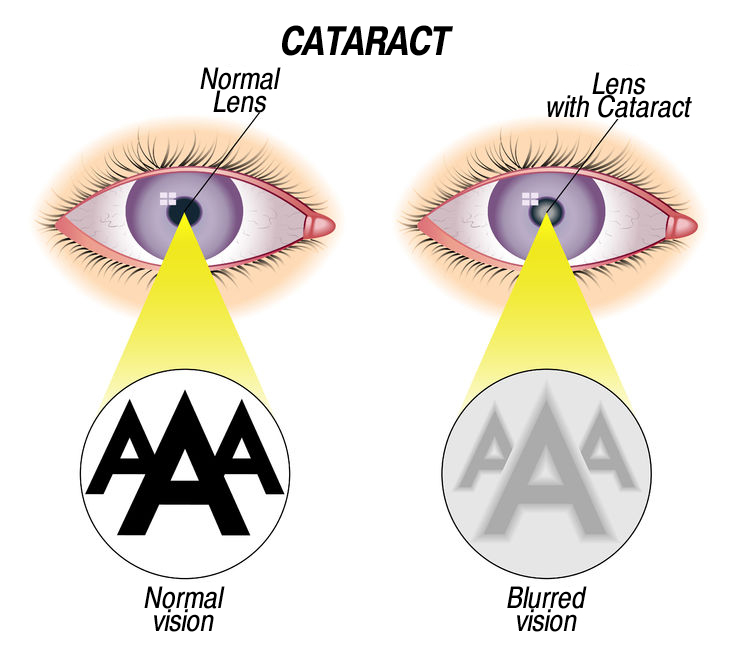
2. Symptoms of Cataract
The most common symptom of cataract is blurred vision, other symptoms include:
- Colours appear dull, particular green and blue
- Double images
- Halo effect around bright light
- Deteriorated night vision, especially night driving
- Change spectacle prescriptions frequently
Nevertheless, the symptoms shown above may indicate other eye diseases. Therefore, if vision gets worse significantly, we recommend you to have a thorough eye check-up by eye specialist. As earlier the disease detected, the better the prognosis of that particular disease. 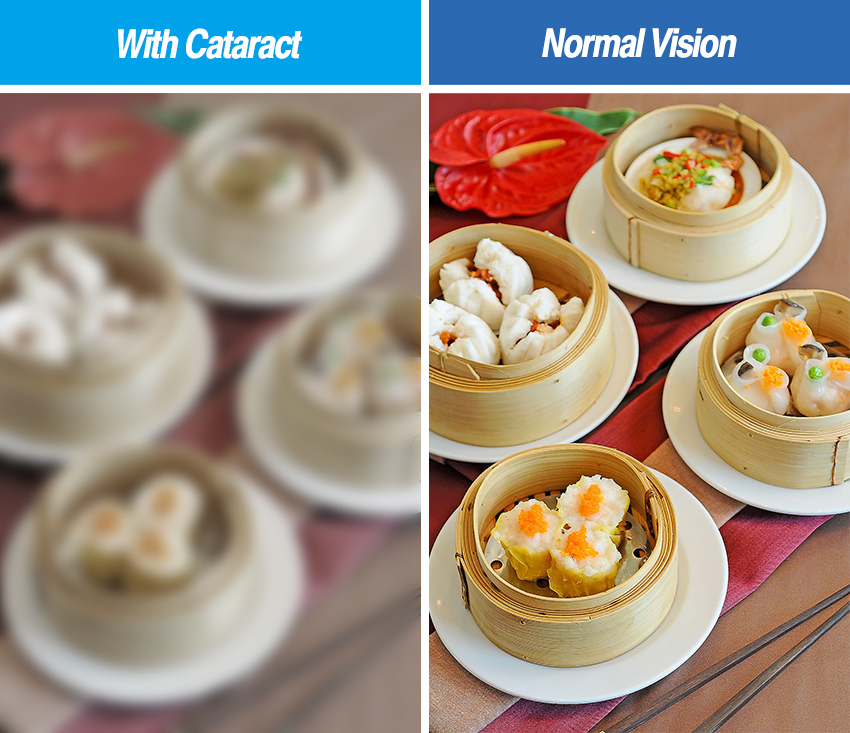
3. Cataract Treatments
Cataract Extraction and Intraocular Lens Implantation procedures is one of the most common treatments for Cataract patients around the world. Our centre offers 2 treatments, they are:
- Femtosecond Laser Cataract Treatment
- Phacoemulsification
VERION Automated Guidance Technology:
During cataract surgery, VERION’s automated guidance technology precisely measures the astigmatism axis, corneal curvature, and refractive data to enable more accurate planning and implantation of the intraocular lens (IOL). VERION provides real-time eye positioning and tracking throughout the procedure, enhancing safety and surgical outcomes, resulting in superior high-definition vision after surgery. 
Femtosecond Laser Cataract Treatment
In 2012, our centre acquired the first Femtosecond Laser cataract surgery system in Hong Kong. Now, we have both Technolas Perfect Vision VICTUS laser cataract surgery system from Germany, and Alcon LenSx laser cataract system from USA.
- The procedure typically is performed on an outpatient basis, it does not require an overnight stay in a hospital
- The first step is to make a small incision in the cornea, and break up the cataract into smaller pieces by the use of laser
- Less ultrasound energy required in laser cataract treatment makes the procedure safer to the inner eye, so there should be less chance of distorting the incision and infections
- It makes incisions as circular as possible and in the right location
Steps of Femtosecond Laser Cataract Treatment
1. Ophthalmologists use a laser to cut a circular incision accurately in the crystal center of the central position, to open the skin of the outer capsule and it's being used to hold the position of the lens.
2. Cut the lens into a specific size using the femtosecond laser.
3. Use ultrasonic and straw to remove the turbid crystals, and then implant intraocular lens.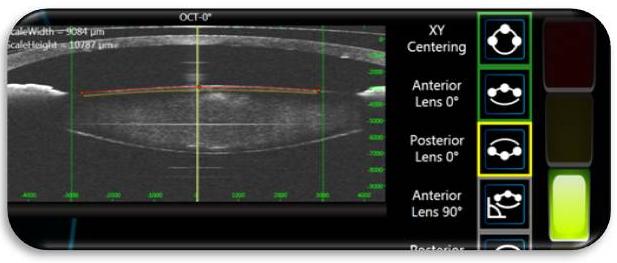
Phacoemulsification
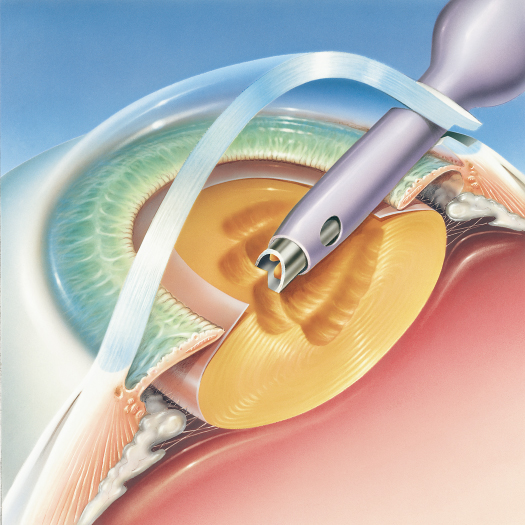
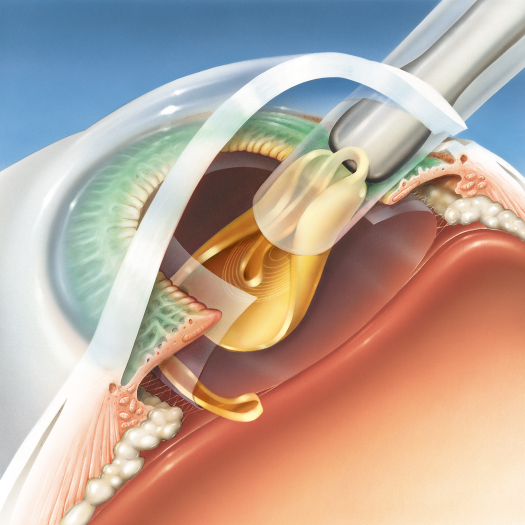
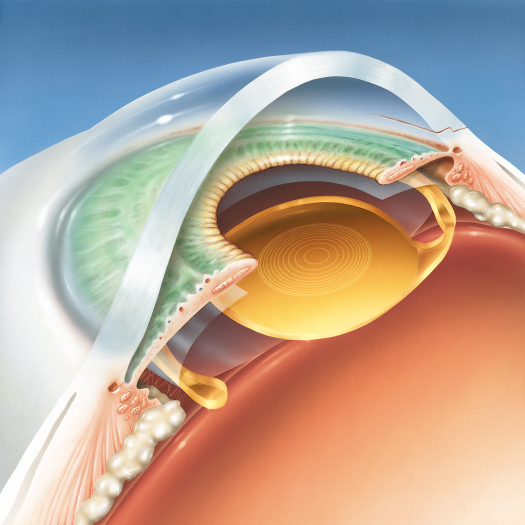
Phacoemulsification is the most common type of cataract surgery. Steps of Phacoemulsification
1. Makes 2-3 tiny incisions (cuts) in your cornea, then a small surgical instrument is inserted into the eye. A special ultrasound device is used to break the cataract into small pieces and suck them out of your eye.
2. Inserts a folded intraocular lens (IOL) inside the lens capsule to replace your own lens
3. The procedure is completed after the position IOL lens is confirmed
4. Types of Intraocular Lens
There are four major types of Intraocular lenses (IOL). They are monofocal, monofocal toric, multifocal, and multifocal toric lenses.Your ophthalmologist will assist you to decide the best lens for suitable your needs in accordance with your lifestyle and the needs of your daily life.
Monofocal
Delivers good vision at one distance: Near, Intermediate, or Far
You may still need to wear your glasses if you have presbyopia or astigmatism
Monofocal Toric
Delivers good vision at one distance: Near, Intermediate, or Far
Astigmatism will be managed
You may still need to wear your glasses if you have presbyopia
Multifocal
Delivers good vision across a range of distances (near, intermediate, and far)
Makes you less dependent on presbyopia glasses
Some patients are aware of a halo around lights at night
Multifocal Toric
Delivers good vision across a range of distances (near, intermediate, and far)
Types of Intraocular Lens
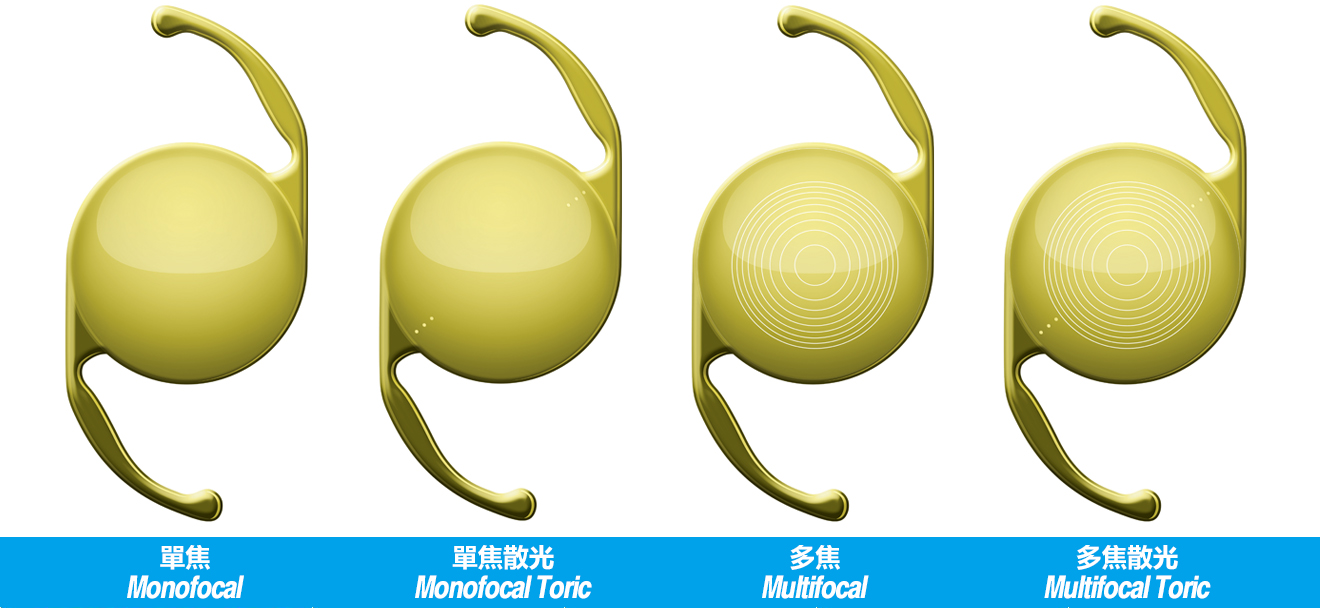
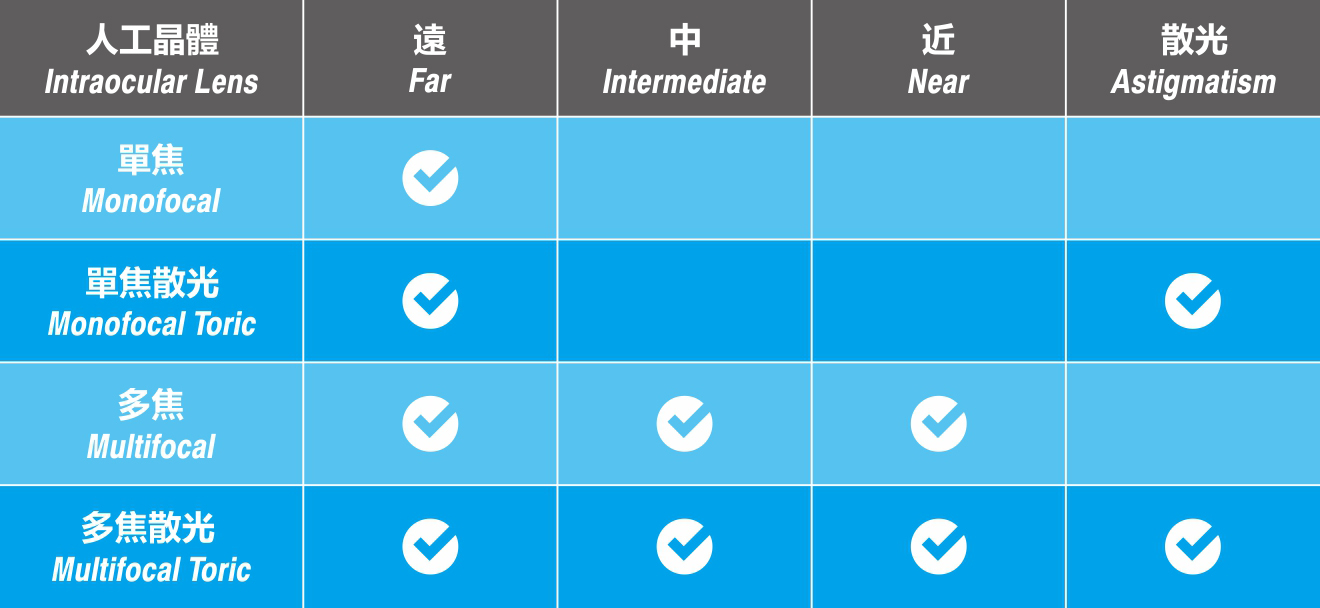
To Correct Refractive Errors (Myopia, Hyperopia, Astigmatism and Presbyopia)
If you need cataract surgery and you want the greatest freedom from eyeglasses after cataract surgery, you might want to consider multifocal intraocular lens (IOLs) to expand your range of clear vision(for myopia, hyperopia, astigmatism, and presbyopia)
- You might want to consider "Aspherical Multifocal IOLs" to eliminate the need of your reading glasses for presbyopia
- With the help of laser vision device, you might correct your myopia, hyperopia, astigmatism, and presbyopia)
5. Should I have Cataract Surgery?
Cataract is not an acute disease. After diagnosed by our ophthalmologists, patients will have plenty of time to decide whether or not to have this surgery. Removal of a cataract may be necessary when vision has worsened to the point that daily activities are affected. Generally, for better outcomes, cataract surgery should be performed soon after vision problems develop rather than waiting many months or years. Untreated cataracts can become "hyper-mature", a condition that makes cataracts more difficult to remove and more likely to cause complications.
- Blurred vision that affect your performance at work
- Difficulties in reading, watching television, eyes feel tired easily
- Difficulties when driving under bright sunlight or at night
- Vision worsen quickly with spectacle even when the spectacles are prescribed recently
- As vision worsen, fear of falling and hitting obstacles & not confident to move around
- Due to the above inconvenience, you need assistance from people around you and minimize social activity
6. Operative Care Before and After Cataract Surgery
(I) Before the Treatment
- In some cases, pre-operative eye drops are prescribed by your surgeon. Please use the eye drops in the surgical eye several days before the surgery as directed by your surgeon
- If you have long term diseases and take some medications (e.g. blood thinners), please check with your surgeon whether you need to stop them before the surgery
- Wash your hair in the evening before your treatment or in the morning of your treatment
- On the day of surgery, please keep your eyes and face clean. Do not use face creams, lotions, make-ups, perfumes, after-shaves and colognes
- Do not wear any jewellery
- Wear comfortable clothes that you no need pull over your head. Avoid wearing dress or skirt
- No fasting is needed
(II) Treatment Day
- As your surgical eye will be covered after surgery, it is recommended that someone can accompany you home
- When you arrive our centre, you will be asked to sign a consent form. Please read the consent form carefully. Please consult our nurse if you have any enquiries
- Our nurse will measure your blood pressure. Then, you will be given eye drop for pupil dilation or other prescribed medications (if any)
- Our optometrist will measure your corneal curvature
- After your pupil is fully dilated, our nurse will assist you to wear protective gown, cap, shoes cover and lead you to the operating room
- You will receive a local anesthetic so you will not feel any pain. But you will remain awake throughout the procedure
- The area around your eye will be sterilized and your face will be covered with a sterile drape with a hole for your eye. Then, an eyelid speculum will be used to hold your eyelids open and prevent you from blinking
- After operating microscope is positioned above your eye, it is crucial for you to remain still and look at the light source from the microscope. Please follow the instruction from your surgeon.
- During the procedure, a plastic ring will be used to hold your eye from blinking. When the suction on, you may feel the pressure and discomfort on your eye. Your vision will dim or you may not see the light. This is normal, please follow the instruction from your surgeon
(III) After the Treatment
- Cleaning of the operated eye: Use cotton bud or sterile cotton to wipe secretions from the eyes. The rest of the face can be mopped with a clean, wet cloth. Avoid splashing water into the operated eye
- Do not rub the eyes. Wear sunglasses during day time
- Please wear eye shield for protection at bedtime for 2 weeks. Please wash and dry the eye shield with soap and water before use
- Use the eye drop in accordance with the doctor’s instruction
- Avoid alcoholic beverages and spicy food.
- Wear loose fitting clothing.
- Do not lift heavy weights
- Avoid swimming, vigorous and contact sports for 4 weeks (After 4 weeks, please wear goggles for swimming for another 4 weeks)
7. Frequently Asked Questions
Is it painful?- Cataract surgery is carried out under topical or local anesthesia. Although patients are awake for the procedure, most of them do not feel pain
- Before the treatment, doctor will decide the lens based on the patients’ particular anatomy, as well as the needs on their daily life. By implanting a suitable lens, it can correct the pre-surgical refractive error (myopia, hyperopia, astigmatism and presbyopia). So, most of them are less dependent on glasses after the treatment
- However, as different people have different demand on vision quality and living need, some people may need a low power glasses to get the best vision
- No, once a cataract has been removed it cannot return. However, over time, the clear membrane that holds the lens in place may become cloudy. The medial term for this is posterior capsular opacification (PCO). Symptoms similar to your cataract return. This can be easily treated by a simple in-office procedure Yap capsulotomy. In this procedure, the laser is used to create a clear "window" in the posterior lens capsule, which quickly restores the vision.
- As cataract surgery is a very safe procedure and just takes 20-30 minutes, you can take the treatment in eye clinic and no need to stay overnight at hospital
- For the patients who have serious cardiovascular diseases, respiratory diseases or for any reasons that the cataract treatment needs to be done under general anesthetic, they need to have cataract surgery at a hospital
8. Discussion with Ophthalmologists
- Do you have serious cataracts and need to be dealt with in a timely manner?
- Which surgery type is suitable for you and what are the risks?
- What Intraocular Lens is suitable for you?
- If a surgery is not urgent, when would be the best time to do so?
9. Feedback from Patients
- With clear vision, patients do not need to rely on others to assist on daily activities
- Enjoy the quality of life and freedom
- No limitation on daily activities
- Life is full of hope again
10. Posterior Capsular Opacity, PCO
- Some people in cataract surgery have issues after one to two years with blurred vision and that cause some people to think that cataract "relapse." In fact, Intraocular Lenses are foreign substances, they have the ability to simulate the Intraocular Lenses after the transparent posterior capsule cell proliferation caused by turbidity, these are generally referred to as "secondary cataract" or "posterior capsular opacification".
- After treatment, capsule capsule opacity is very simple, only need to use YAG laser in the turbid capsule on the piercing a hole (not surgery), the light can once again clearly project onto the retina, restore vision. YAG laser takes only a few minutes in the consultation room.
11. Scheduled Weekly Seminar
We organise various Eye Health Seminar every week. It is free to book, please contact us for details.
Please reserve your seat at 2628-1111(Tsim Sha Tsui), 2526-3333(Central) or our website www.hklasereye.com/en/booking.


